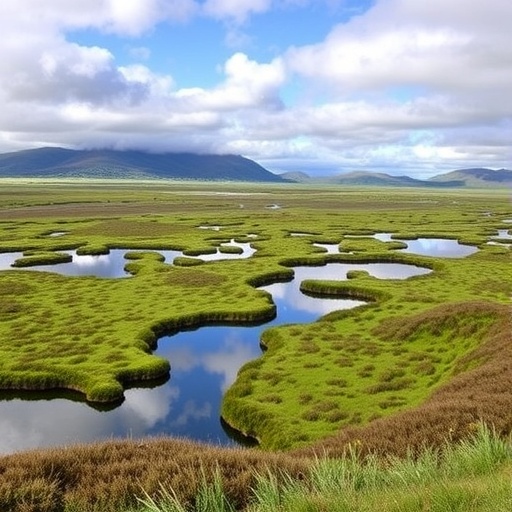Over the course of early September, a coalition of approximately 40 experts, policymakers, researchers, and stakeholders gathered virtually to advance peatland and wetland restoration efforts across Germany, the Netherlands, and Finland. Convened between the 2nd and 10th of the month, these intensive online workshops aimed to forge impactful national strategies that catalyze policy reforms and innovative market mechanisms to safeguard and rehabilitate these vital ecosystems. Given peatlands’ significant role in carbon sequestration and biodiversity preservation, the urgency for coordinated restoration has never been greater, prompting this unprecedented multinational collaboration.
The workshops were orchestrated by leading environmental initiatives, including the EU-funded WET HORIZONS project, the United Nations Environment Programme’s Global Peatlands Initiative, Wetlands International, and Eurosite—the European Land Conservation Network overseeing the European Peatlands Initiative. This consortium reflects a comprehensive approach that bridges scientific research, governmental policy frameworks, and conservation practice, underscoring the complexity of effective peatland management in a rapidly changing climate context.
Participation predominantly featured researchers from diverse universities, research institutions, and federal agencies, representing an intersection of social and natural sciences. This multidisciplinary engagement fostered comprehensive dialogue encompassing ecological functions, socio-economic challenges, and governance dimensions critical to peatland restoration. Additionally, voices from environmental non-governmental organizations and a select group of private-sector entities contributed to enriching the discourse, facilitating a broader understanding of potential collaborative pathways.
A central focus of the workshops was identifying mechanisms to expedite the protection and restoration of peatlands within national contexts. Germany, the Netherlands, and Finland, each possessing distinct peatland landscapes and policy environments, offered unique challenges and opportunities. Collective discussions revealed converging priorities, such as reinforcing legal instruments for habitat preservation, leveraging ecological data for informed decision-making, and enhancing stakeholder engagement across sectors.
A key area of exploration centered on policy innovation and the harmonization of funding streams across diverse governance domains. The Nature Restoration Law emerging from European Union directives provides a timely framework within which integrated public funding can be aligned to maximize restoration outcomes. Workshop participants considered the strategic deployment of public capital to mitigate risk and attract private investment, notably through emerging carbon market instruments tailored for peatland ecosystems.
The national impact plans resulting from this process articulate precise objectives that intertwine policy effectiveness with operational accountability. By mapping clear tasks to overarching environmental goals, the plans aspire to drive coordination among governmental bodies, NGOs, and financing bodies. This structured approach also promotes transparency in funding allocation and progress tracking, thereby reinforcing a culture of shared ownership and sustained commitment to restoration targets across the participating countries.
Beyond strategy formulation, the workshops initiated active dialogues to facilitate knowledge transfer and reciprocal learning. Upcoming initiatives include targeted workshops designed to share empirical evidence and policy experiences among the three focus countries and with additional actors in the European peatland restoration community, including Scotland. This cross-border exchange fosters adaptive management practices, especially pertinent as Scotland pilots innovative funding blends that combine public funds with private capital to scale restoration.
The conversation also highlighted the potential for paludiculture—the cultivation of wetland crops on rewetted peatlands—as a nature-based solution that partners well with carbon market mechanisms. By valorizing ecosystem services through biochar production and carbon credits, paludiculture may offer a dual pathway to economic viability and ecosystem health. Workshop attendees underscored the need for coordinated research and policy frameworks to realize this potential at scale.
Emphasizing technological advancements, the gatherings spotlighted the integration of remote sensing technologies, particularly radar-based methods, to monitor peatland conditions accurately. Combining these insights with restoration practices like forest-to-bog transitions enhances the precision of carbon accounting in peatlands, thereby strengthening the credibility and robustness of carbon market participation. These technical innovations are essential for informing adaptive management and measuring the outcomes of restoration investments effectively.
The synergy generated by bringing together stakeholders actively engaged in peatland restoration fuels optimism for future collaborative ventures. Shared objectives and mutual recognition of challenges create fertile ground for joint learning and collective action, transcending national boundaries. Such partnerships will likely accelerate restoration pathways that reconcile ecological needs with socio-economic considerations.
Sustained momentum post-workshop is envisioned through ongoing engagement facilitated by the WET HORIZONS coordination team based at Scotland’s Rural College alongside UNEP’s Global Peatlands Initiative and Wetlands International. This continued support aims to underpin the implementation of impact plans and contribute substantive insights toward an internationally coordinated Peatland Breakthrough strategy—a concerted global effort targeting peatland conservation and restoration as a climate and biodiversity imperative.
Rooted in findings of the first UNEP Global Peatlands Assessment, the Peatland Breakthrough represents a landmark initiative that assembles public and private stakeholders to elevate peatlands’ role within climate policies and promote restorative land-use practices such as paludiculture. This collective action framework is critical for meeting ambitious climate mitigation and biodiversity conservation targets while safeguarding ecosystems and the livelihoods dependent on them.
Ultimately, this multi-layered approach integrating science, policy, funding innovation, and community engagement embodies a transformative step towards large-scale peatland restoration across Europe. By aligning diverse actors under a shared vision, the initiatives emerging from these workshops exemplify how coordinated international cooperation can translate ecological knowledge into tangible environmental outcomes, fostering resilience in the face of escalating global environmental challenges.
Image Credits: Louis Johansen Skovsholt, Aarhus University
Web References:




